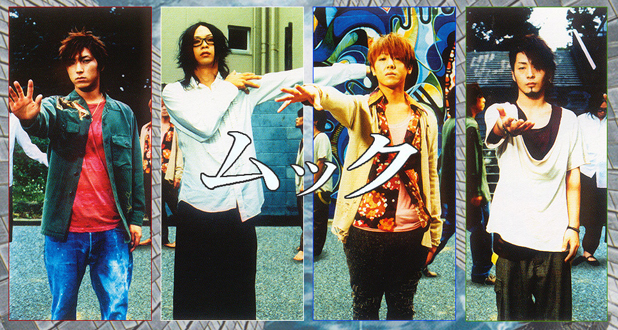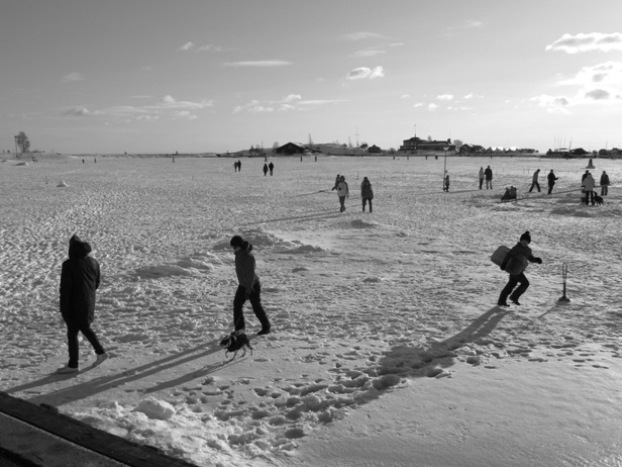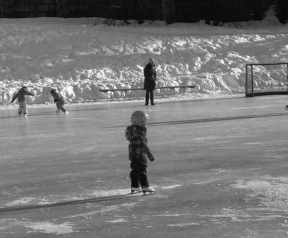Surrounded
by old projectors and film star photos at the Motion Picture museum in
Helsinki, Aku Louhimies speaks calmly, even when discussing his latest movie Man Exposed (Rissuuttu Mies, 2006) that has been recently banned by the Court of
Appeal of Helsinki. He does not seem to give much importance to his awards, as
he is already working on his next film, which he describes as a “dark love
story during the Finnish Civil War”. This new movie sounds like a different and
challenging project for a director specializing in modern and urban stories. He
enjoys shooting the city and analyzing complicated human relations that are resolved
in an inevitable solitude.
How do you find stories worthy to be made into
a film?
I read a
great deal and I find a lot of different kinds of ideas and stories, but I also
have to think about the investors, about what kind of a movie they are looking
for.
How involved do you like to get in the writing
of the screenplay?
In general,
I hope the screenwriter will be in the process from the beginning until the
film is on the screen, since it’s a really important cooperation. I assume that
here in Europe we need to start to work together already from the beginning.
Usually in Finland it does not happen that there is a very good script already
finished and on my desk, so I think it is always a close cooperation.
{mosimage}There appears to be some recurrent topics in
your movies, such as the portrayal of the city in Kuutamolla (Lovers and Leavers) and Valkoinen Kaupunki (Frozen
City).
In the
films I have made so far, the city has played a big part, but my next film is
not going to be set in a city; it depends upon the story. For example, for me Kuutamolla was a realistic way
of looking at Helsinki. I also think that Valkoinen Kaunpunki is a realistic way of examining a different part of the same city.
However, the people who select the films for the Berlin International Film
Festival said that Kuutamolla
didn’t look like Finland and there was not enough Finnishness. So, you never
know…
What were they expecting of Finland?
I’d guess
probably something sad, or maybe an Aki Kaurismäki type of film.
Sex is also a recurrent topic in your film. Is
there any message involved?
I don’t
think if there is only one clear message, but it’s a subject in which I have
been interested and I wish that we could show things differently, like in
mainstream Hollywood films when characters meet, kiss and then it fades into
next morning. In Riisuttu Mies (Man Exposed), there
is a scene in which the guys are coming out of sauna and start wrestling. There
is full frontal male nudity, but you cannot have that in the US. It would be
like an X-rated film, which I think is really funny. I want to express it in a
more natural way…I hope it is not that big a deal.
In both Restless
and Man Exposed one of the main
characters is a priest. Why is this?
When you
think about human relationships, the one with a priest is one of the most interesting.
We expect them to be better in a way, especially in a Protestant church with
women priests as well; this profession can get very interesting.
You also like focusing on the family.
When you
are a film director it’s not very easy to be a good husband and father at the
same time, but I try to combine both. Those are also subjects in which I’m
interested. Kids are interesting.
Is working with them so painful like some other
directors say?
No, I
really like working with kids. I also like working with animals. I have only
good experiences.
The character of the mother leaves home
in both Kuutamolla and in Valkoinen Kaupunki. Do you want to stress the
importance of the mother in the family?
In Kuutamolla, this situation was already in the book. It is a stereotype that
it’s the man’s departure that only destroys the family; the woman can leave
too. Valkoinen Kaupunki is told from the
point of view of the man for the audience to identify with his drama. It has to
do with the fact that when something goes wrong in the marriage, everybody
tends to point his finger – it is not always like that.
I noticed that another connection between those
movies is Martin Scorsese’s Taxi Driver
and loners.
Yeah,
that’s right. I like that film a lot. I like how it portrays loneliness and it
is a meaningful film for me. When I read Katja Kallio’s book, which had
references from lots of films, this part specially came to my mind. It also has
to do with the fact that film was distributed by Columbia, so we could have the
rights to show parts of Taxi Driver
in our movie. In Valkoinen Kaunpunki it’s a
bit different; it’s like a homage referring to loneliness. I can easily find
that loneliness has been one of the themes through all of my films – Iiris in Kuutamolla is also quite lonely,
in a way.
Do you think that is an influence of Finnish
society?
I think
that’s one of the things. It’s definitely cultural. This is a very different
country than, say, Spain. It’s different how people walk around the city and
how they interact with one another.
However, it has been said that your
movies don’t really reflect Finland and that they are not realistic.
For me,
they have been quite realistic. They are not showing the whole picture of
Finland. They show just one small part, but I think they are realistic. I
understand, though, that the {quotes}Helsinki of Valkoinen Kaupunki or Paha Maa is not the
city shown at the tourist information office.{/quotes}
Most people remember Levottomat (Restless) because of its sex scenes. Are you concerned that the
audience will remember one part of the story?
It is far
more interesting if movies have different layers and you can watch them several
times, going deeper into it with each viewing. It has to be the same way with
advertising. When Restless has gone
to international festivals people did not pay attention to sex or who the
actors were. They can access the story easier and find the theme of loneliness
than people in Finland, who know the actors and have seen the promotion. It
happens with other films in the same way, they have done well internationally,
but they didn’t find many viewers in Finland.
Does this fact annoy you?
No, not
really, because you cannot always please everybody and a filmmaker cannot keep
in mind the audience response all the time.
Do you think much about the audience when doing
the films?
Yes, in a
way, but also, in a way, not at all. When I’m preparing a scene, I’m thinking
about how they should be acting and how we can shoot this, and then I don’t
think about the audience.
A difficult
director?
Can you explain more about the troubles you had
with producer Markus Selin with the editing of Paha Maa?
It was a
matter of who has the final cut in European cinema. Traditionally in Finland,
the director has the right over the final cut. Films are not a bad business.
There is not a big risk for production companies, although they try to make it
look like that. Costs are paid with governmental institutions and the presale
of television rights. The problem was solved and the end result was fine, although
the problem received some publicity. I’m sure producer is happy now, because,
although it was not a mainstream film, it attracted a lot of viewers and it has
been distributed in the Scandinavian countries, in the Benelux and in the UK.
It has done well.
And now you have a problem with Riisuttu Mies.
It is quite
different because I’m not legally part of that argument at all. My contracts
are fine. The screenwriter Veli-Pekka Hänninen is an old friend of the producer
and their contracts have some strange things that don’t really fit in the
normal way of filmmaking. I have never seen them but it kind of says that the
screenwriter could have a final cut of the film. That might be if you are in
the United States and you are Stephen King or Michael Crichton. Maybe those
guys could have the final cut. If I had known that there was this kind of
arrangement, I would have not worked on Riisuttu Mies. I do commercials sometimes and I know how it works. You work as a
hired gun, but I would not do a feature film in Finland as a hired gun.
Everything is fine from my point of view besides the end result of the court.
You seem to be taking it very calmly.
I cannot
believe it is going to be the end result. It is ridiculous. If there has been
something wrong with the contract, I think it is good if the producer pays
something to the screenwriter; I don’t have anything against that, but since
the film was already made it is very dumb not to allow all the work of
cinematographers, editors, composers and actors, for example, to be seen. There
were several film festivals around the world that have been interested in the
film and now they don’t have the possibility of showing it. It was supposed to
be shown in Gothenburg. {quotes}Banning Riisuttu Mies is a very dumb decision.{/quotes} I don’t think it is going to be this
way in the end.
What is it like working with actors?
I cannot
really say in general. I want them to give something I can believe and
something that I can feel emotionally or intellectually. Some people like
rehearsing, others hate it, but is it rehearsing when you go for a cup of
coffee? Why not? To me, it’s very important to get to know the people with
which I am working.
There’s no better example of this than
with your own wife Laura Malmivaara, who appears in several of your movies. Is
it stressful to mix work and family?
It helps in
the way that you will work with somebody you already know, so you can get to a
great level of confidence. Maybe sometimes it’s little bit more stressful, but
mainly it is a benefit.
Five movies
Let’s talk about your movies. Your first
one was Levottomat.
It took me
many years. It took around five years to get the financing for the film. It is
really hard to breakthrough in a small country like Finland where only about
ten feature films are made every year. It was an important story for me at that
time. It was hard to get the first one done.
{mosimage}Next came a bittersweet love story, Kuutamolla.
I read
Katja Kallio’s book and I thought that this would make a good movie, and then
the producer also thought it was a good idea. We met with Katja Kallio and we
thought that we could work together. I approached her and she approached me at
the same time in a way. It was a really nice cooperation.
Paha Maa was a hit and critically
acclaimed.
I already
had that script ready for almost 14 years before I was able to do it. I think
it was more experimental when it comes to the structure. It also felt important
to do.
Man Exposed brings back the figure of a priest.
There was
no script in the beginning and we developed as we worked. I wanted to do
something that would be lighter than Frozen
Land and it is closer to Lovers and
Leavers. The main character, played by Samuli Edelmann, is a priest whose
wife is also a priest and the story follows their marriage and not having kids.
The last is Valkoinen Kaupunki, a very tough story.
In a way it
is also really experimental. It is made with small cameras. It was also
personally important for me to be done.
Valkoinen Kaupunki and Paha Maa have very
similar titles in English, but not in Finnish. Why is that?
I think
‘Frozen Land’ is a good translation. It expresses the same ideas as in Finnish.
It is even better than in Finnish. However ‘Frozen City’ is a mistake because
it should have been ‘White City’. Perhaps production companies thought it would
work better to present it like a sequel to Paha Maa, which it is not. I think the audience is going to get confused and
think it is the same movie.
Photos by J.M. Rodríguez


